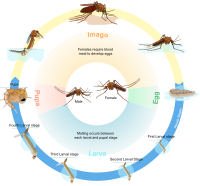
Photo from wikipedia
Phytoplankton dynamics are regulated by external cues, such as light and nutrients, as well as by biotic interactions and endogenous controls linked to life cycle characteristics. The planktonic pennate diatom… Click to show full abstract
Phytoplankton dynamics are regulated by external cues, such as light and nutrients, as well as by biotic interactions and endogenous controls linked to life cycle characteristics. The planktonic pennate diatom Pseudo-nitzschia multistriata, with a heterothallic mating system with two opposite mating types (MTs), represents a model for the study of diatom life cycles. P. multistriata is a toxic species, able to produce the neurotoxin domoic acid. First described in Japan in 1993, it was detected at the long-term monitoring station MareChiara (Gulf of Naples, Italy) in 1995. Since then, P. multistriata has been reported from several worldwide coastal sites. A large body of knowledge has been produced on its ecology, genetic diversity, and life cycle characteristics. The availability of these data, the ecological relevance of the Pseudo-nitzschia genus, and its controllable life cycle with a short generation time made it an ideal species to develop a genetic model system for diatoms. To enable functional studies, a 59 Mb genome sequence and several transcriptomic data were produced, and genetic transformation was optimized. These tools allowed the discovery of the first mating-type determining gene for diatoms. Gene expression studies and metabolomics analyses defined genes and molecules underpinning different phases of the process of sexual reproduction. This model system, developed to explore the genetics of diatom life cycles, offers the opportunity to parallel experimental observations in the laboratory using in situ meta-omics analyses along space and time, empowering knowledge on the biology and ecology of the genus.
Journal Title: Journal of phycology
Year Published: 2023
Link to full text (if available)
Share on Social Media: Sign Up to like & get
recommendations!